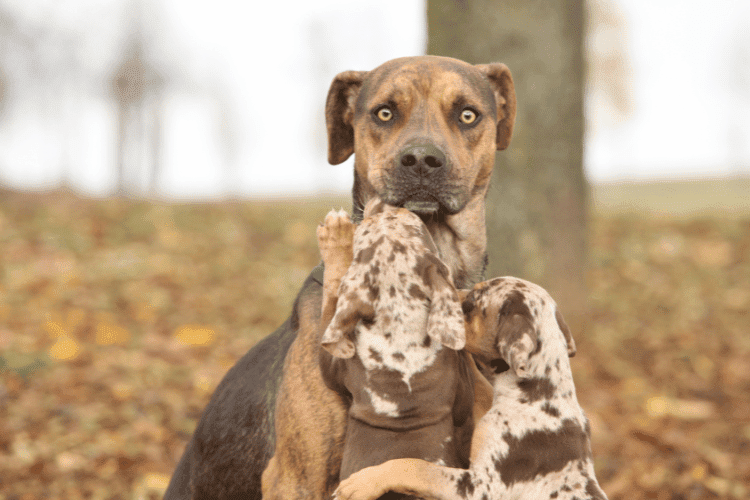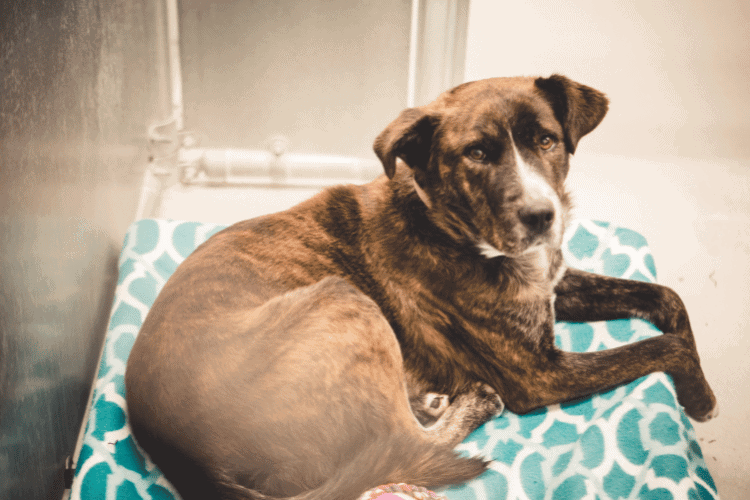For a lot of people, an important consideration when getting a dog is its gender. It's no different with the Catahoula Leopard dog breed.
Some characteristics of a female Catahoula Leopard dog can be somewhat distinct, but not all of them are completely sex-linked. We can attribute size, sexual maturity, and even behavior to a lot of other factors aside from sex.

Female Catahoula Leopard Dog Physical Characteristics
The Catahoula Leopard dog is American Kennel Club (AKC)-recognized and has its own breed standards for physical characteristics. Do these standards remain the same for both male and female Catahoulas?
Physical Growth
Similar to other medium-sized breeds, female Catahoulas can slightly stray away from their AKC breed standards.
The usual trend is that female Catahoulas tend to be smaller in terms of height and weight. They average around 20 to 24 inches in height and 50 to 65 pounds in weight.
This isn't strictly due to their biological gender, though.
You have to take note that gender isn’t the only influencing factor. Other factors include your female Catahoula’s diet, activity and exercise levels, and pedigree.
Sexual and Physical Maturation
When female Catahoulas reach sexual maturation, hormonal changes affect their behavior significantly. They’ll begin to undergo regular heat cycles and will also exhibit some physical changes.
Now, when it comes to physical maturity, there are a lot of papers that report female puppies reaching maturity faster. However, a study by Hoffman et al. revealed that sex plays a very minimal role in maturation and aging.
Catahoulas, regardless of sex, reach physical maturity at an average age of two years.
Important Considerations to Keep in Mind About Female Catahoula Behavior
According to an article by the AKC, determining if certain behaviors are directly connected to biological gender can be challenging—even scientists themselves attest to it!
We have to be careful not to impose our own human gender stereotypes on dogs because technically, animals can’t have genders. We have to be able to differentiate between sex-specific differences and training issues.
Hence, we have to anchor all of the observed behaviors of female dogs on science-based, biological facts. We also have to recognize that your female Leopard Catahoula’s training, individual temperament, and socialization can all contribute to her behavior.
Female Catahoula Leopard Dog Behavior
Now, let’s take a look at some of the behaviors you might notice in your female Catahoula Leopard dog.
Less Likely to Show Aggression

Because of certain human gender stereotypes, you might assume that a female Catahoula is less playful, more serious, and aggressive. This stems from the assumption that males are usually more aloof.
The truth is, Catahoulas, in general, are very focused and disciplined working dogs regardless of gender. People often label them as aggressive because they tend to assert themselves when threatened.
According to the Royal Society for the Prevention of Cruelty to Animals (RSPCA), male and female dogs of all breeds can both exhibit aggression. However, intact or unneutered male dogs tend to be more aggressive than their counterparts.
In short, your female Leopard Catahoula is actually more relaxed and less prone to exhibit aggressive behaviors than a male dog.
Easy to Train
Your female pup will have the specific breed characteristic of a Catahoula, which makes training incredibly easy. However, her individual temperament also affects how smoothly training will go.
There’s an existing assumption that female dogs are smarter than their counterparts. Canine behaviorists argue that this has more to do with maturity than intelligence.
Female Catahoulas may seem easier to train, not because they’re smarter, but because they can reach maturity faster. A more mature dog will be able to respond better to training.
Highly Sociable
Female Catahoula Leopard dogs are highly sociable. They’re a lot less territorial than males, which means they’ll likely get along with other pets in your household.
In addition to this, they’re less wary of strangers. You’ll find that your female Catahoula is very docile and relaxed most of the time.
Female Catahoula Leopard Dog’s Temperament During Heat Cycles

Unlike male dogs, who are sexually active all year round, a female Catahoula Leopard dog will usually be in heat only twice per year.
Below is a short list of changes you should expect your female Catahoula to go through during heat cycles:
- Swelling of the vulva
- More frequent urination
- Red vaginal discharge lasting around 7 to 10 days
- Aggression
- Irritability and nervousness
Remember, understanding your pup’s temperament—yes, even when in heat—is essential to establishing a successful and trusting relationship.
Part of being the owner of a female Catahoula Leopard dog is knowing what to expect and what to do during heat cycles. This is especially true if you don’t plan on spaying her in the future.
Should You Spay a Female Catahoula Leopard Dog?
Experts recommend spaying female Catahoulas—and all female dogs in general—to significantly lessen the risk of the following conditions:
- Uterine cancer
- Ovarian cancer
- Breast cancer
- Mammary tumors
- Uterine infections
Another reason for spaying is that a spayed female dog will no longer undergo heat cycles. This eliminates the hormonal fluctuations and behavioral changes that come with a female dog in heat.
However, it’s important to note that spaying isn’t the be-all-end-all solution to every single behavioral problem. While it may help correct certain behaviors, it’s not a replacement for your female Catahoula Leopard dog’s training.
When Should You Get a Female Catahoula Leopard Dog
First, you have to ask yourself if you plan on breeding your Catahoula. If you do, and you already have a male Catahoula as a sire, then prioritize getting a healthy dam to birth the pups.
Needless to say, make sure both sire and dam are healthy, fertile, and come from responsible and reputable breeders.
Another consideration is if you already have a lot of dogs at home, you may want to think about your next pet's sex carefully.
Some combinations work well together and will minimize the risk of dog-on-dog aggression.
Jessica Freni, an AKC Breeder of Merit, often recommends a male-male or female-male household. Two females tend to be more aggressive towards one another.

Paul has been creating content for the dog niche for many years. The information he shares comes his first hand experience growing up in dog lovers household and then owning multiple dog breeds of his own as an adult. Paul enjoys doing the hard research to collect, analyze and present our dogtemperament.com readers with the best answers to their questions.